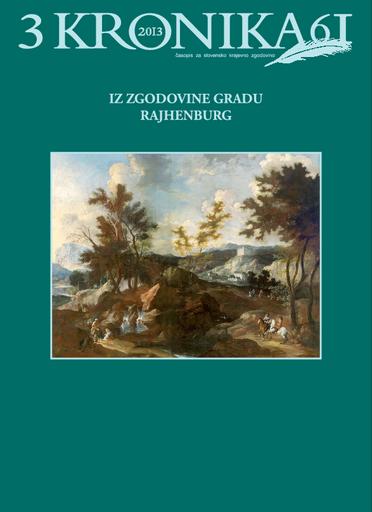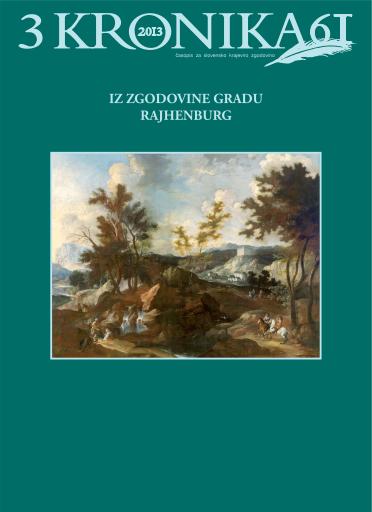/
Serijske publikacije
/
Kronika: časopis za slovensko krajevno zgodovino
Grad Rajhenburg kot muzej

Avtor(ji):Irena Fürst
Soavtor(ji):Miha Preinfalk (odg. ur.), Barbara Šterbenc Svetina (teh. ur.), Alenka Cizel (prev.), Manca Gašperšič (prev.), Andreja Jankovič Deržič (prev.), Dejan Zadravec (prev.), Lidija Slana (prev.), Meta Osredkar (prev.), Agencija MultiLingual (prev.), Irena Bruckmüller Vilfan (prev.)
Leto:2013
Založnik(i):Zveza zgodovinskih društev Slovenije, Ljubljana
Vir(i):Kronika, 2013, št. 3
Jezik(i):slovenščina
Vrst(e) gradiva:besedilo
Ključne besede:Grad Rajhenburg, Muzej slovenskih izgnancev, Muzej političnih zapornikov, internirancev in izgnancev, razstava o menihih trapistih, spomenik nacionalnega pomena, spomenik narodnoosvobodilne vojne, denacionalizacija, kulturni spomenik državnega pomena, Rajhenburg Castle, Museum of Slovenian Exiles, Museum of Political Prisoners, Internees and Deportees, Trappist monk exhibition
Avtorske pravice:

To delo avtorja Irena Fürst je ponujeno pod Creative Commons Priznanje avtorstva-Nekomercialno-Brez predelav 4.0 Mednarodna
Datoteke (1)

Ime:kronika-2013_3.pdf
Velikost:66.73MB
Format:application/pdf
Stalna povezava:https://hdl.handle.net/11686/file18349
Opis
V članku avtorica opisuje zgodovino muzejskih in spremljajočih dejavnosti na gradu Rajhenburg in upravitelje
ali lastnike gradu po ukinitvi zaporov. Seznanja, kdaj so bile odprte posamezne muzejske zbirke, ki so predstavljale
najpomembnejša poglavja zgodovine gradu, in kako se je muzej kot ustanova imenoval, kdaj je bil razglašen za
spomenik in kakšen je bil rezultat postopka denacionalizacije, ko je Škofija Maribor v imenu menihov trapistov
zahtevala vrnitev po vojni odvzetega premoženja. Občina Krško, ki je zemljiškoknjižni lastnik gradu, je grad v
celoti obnovila in ga za javnost odprla 1. decembra 2012.
Metapodatki (12)
- identifikatorhttps://hdl.handle.net/11686/35002
- naslov
- Grad Rajhenburg kot muzej
- The Rajhenburg Castle as a Museum
- ustvarjalec
- Irena Fürst
- soavtor
- Miha Preinfalk (odg. ur.)
- Barbara Šterbenc Svetina (teh. ur.)
- Alenka Cizel (prev.)
- Manca Gašperšič (prev.)
- Andreja Jankovič Deržič (prev.)
- Dejan Zadravec (prev.)
- Lidija Slana (prev.)
- Meta Osredkar (prev.)
- Agencija MultiLingual (prev.)
- Irena Bruckmüller Vilfan (prev.)
- predmet
- Grad Rajhenburg
- Muzej slovenskih izgnancev
- Muzej političnih zapornikov, internirancev in izgnancev
- razstava o menihih trapistih
- spomenik nacionalnega pomena
- spomenik narodnoosvobodilne vojne
- denacionalizacija
- kulturni spomenik državnega pomena
- Rajhenburg Castle
- Museum of Slovenian Exiles
- Museum of Political Prisoners, Internees and Deportees
- Trappist monk exhibition
- opis
- V članku avtorica opisuje zgodovino muzejskih in spremljajočih dejavnosti na gradu Rajhenburg in upravitelje ali lastnike gradu po ukinitvi zaporov. Seznanja, kdaj so bile odprte posamezne muzejske zbirke, ki so predstavljale najpomembnejša poglavja zgodovine gradu, in kako se je muzej kot ustanova imenoval, kdaj je bil razglašen za spomenik in kakšen je bil rezultat postopka denacionalizacije, ko je Škofija Maribor v imenu menihov trapistov zahtevala vrnitev po vojni odvzetega premoženja. Občina Krško, ki je zemljiškoknjižni lastnik gradu, je grad v celoti obnovila in ga za javnost odprla 1. decembra 2012.
- In the following article, the author delineates the history of the museum and accompanying activities at the Rajhenburg Castle and its managers and owners after the abolition of the prisons. An overview of when the separate museum collections that represent the most important chapters in the Castle's history were opened, and how the Museum was named as an institution, when it was proclaimed a cultural monument, what the result of the process of denationalization was, when the Diocese of Maribor demanded the return of property seized after the war in the name of the Trappists. The Municipality of Krško, owner of the Castle, fully restored the Castle and opened it to the general public on 1st December 2012
- After the abolition of the Penal detention centre in 1966, the Brestanica Tourist Society took over as the Castle's caretakers. In collaboration with various institutions, the Museum of Slovenian Exiles opened in the Castle in 1968. The Slovenian exiles exhibition by Dr. Tone Ferenc was expanded in 1971 and 1975. In June 1975, the Krško Municipal Assembly made the ZZB NOV (a union of combatants of the National Liberation Army from WWII) manager of the Castle and Museum. They started collaborating with the Museum of the Peoples' Revolution of Slovenia in Ljubljana. At first the Museum in Ljubljana only carried out professional quality control, but in March 1979, the Museum of Slovenian Exiles became an integral part of the Museum of the Peoples' Revolution of Slovenia. On 4th July 1981, an exhibition on political prisoners and internees was opened, prepared by the Museum of the Peoples' Revolution of Slovenia, and the Museum was renamed the Brestanica Museum of Political Prisoners, Internees and Deportees. In September 1993, the Trappists in Rajhenburg exhibition was opened, prepared by Irena Fürst, along with the restored Renaissance tract with frescoes. An overview of the Castle's history was prepared in June 1995, along with the exhibition Brestanica through Time, celebrating 1,100 years since the first written record of the Castle. The Brestanica Museum of Political Prisoners, Internees and Deportees was renamed the National Museum of Contemporary History, Brestanica Branch in 2001, a name it has kept to the present day. In 1974, it was proclaimed a first class cultural monument, in 1986, a monument of the National Liberation War and in 1999, a national cultural monument. In March 1993, the Diocese of Maribor demanded the return and denationalization of the property seized after the war in the name of the Trappist Monastery; the procedure ended in 2004. The Ministry of Culture determined that the rightful claimant is to receive compensation in the form of state bonds, while the Municipality of Krško became the owner of the Castle in the land registry.
- založnik
- Zveza zgodovinskih društev Slovenije
- datum
- 2013
- tip
- besedilo
- jezik
- Slovenščina
- jeDelOd
- pravice
- licenca: ccByNcNd
